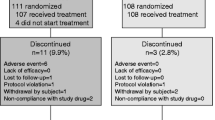Abstract:
Recent experience from different groups suggests that low fluoride doses resulting in moderate increases in bone mineral density (BMD) may be advantageous in terms of fracture-reducing potency. In a randomized prospective 3-year study we examined the therapeutic efficacy of different dosages of monofluorophosphate (MFP) plus calcium in comparison with calcium alone in 134 women with established postmenopausal osteoporosis (mean age 64.0 years, average vertebral fractures per patient 3.6). Group A received 1000 mg calcium/day and a low-dose intermittent MFP regimen (3 months on, 1 month off) corresponding to an average daily fluoride ion dose of 11.2 mg. Group B received 1000 mg calcium/day plus continuous MFP corresponding to 20 mg fluoride ions per day. Group C was treated with 1000 mg calcium alone throughout the study period. Bone density was measured with dual-energy X-ray absorptiometry at L2–4 and three proximal femur areas and with single photon absorptiometry at two radius sites. New vertebral fractures were identified from annual lateral radiographs of the spine. A significant reduction in subjective complaints as measured by a combined pain–mobility score (CPMS) was found in both fluoride groups in comparison with the calcium monotherapy group. Group A showed increases in BMD at all six measuring sites, reaching +12.6% at the spine after 3 years. In group B we found significant increases at the spine, Ward’s triangle and distal radius, but slight decreases at the femoral neck and radius shaft. For the spine the average change amounted to +19.5% after 3 years. In group C losses of BMD were observed at all six sites, with an average loss of 1.6% for the spine at the end of the study. The incidence of new vertebral fractures per 100 patient-years was 8.6, 17.0 and 31.6 in groups A, B and C, respectively. In conclusion, both calcium–MFP regimens resulted in significantly lower vertebral fracture rates than calcium monotherapy. However, the low intermittent MFP regimen, leading to a mean annual increase in spinal BMD of only 4.2%, showed a clear trend to greater effectiveness in reducing vertebral fracture than the higher fluoride dosage that was followed by an average spinal BMD increase of 6.5% per year. Furthermore the rate of fluoride-specific side effects (lower-extremity pain syndrome) was 50% lower in patients receiving the lower fluoride dosage.
Similar content being viewed by others
Author information
Authors and Affiliations
Additional information
Received: 3 November 1997 / Accepted: 4 June 1998
Rights and permissions
About this article
Cite this article
Ringe, J., Kipshoven, C., Cöster, A. et al. Therapy of Established Postmenopausal Osteoporosis with Monofluorophosphate plus Calcium: Dose-Related Effects on Bone Density and Fracture Rate . Osteoporos Int 9, 171–178 (1999). https://doi.org/10.1007/s001980050132
Issue Date:
DOI: https://doi.org/10.1007/s001980050132




